Impact of Vertical Wind Shear on Summer Orographic Clouds over Tian Shan Mountains: A Case Study Based on Radar Observation and Numerical Simulation
Abstract
:1. Introduction
2. Field Experiment and WRF Model Setup
2.1. Field Measurement and Instrumentation
2.2. WRF Model Setup
2.3. Description of the Case and Ambient Conditions
3. Results
3.1. Vertical Structure and Temporal Evolution of the Orographic Clouds as Observed by Radars
3.1.1. Characteristics of Precipitation Observed by MRR
3.1.2. Characteristics of Cloud Observed by Cloud Radar
3.2. Impact of Vertical Wind Shear on Clouds as Interpreted from Model Simulation
3.2.1. Model Evaluation
3.2.2. The Impact of Vertical Wind Shear on Clouds
4. Discussion
5. Conclusions
- (1)
- The MRR measurements show that the case presented in this paper had three segments of precipitation. The precipitation was light to moderate and no strong convection occurred. The precipitation was mainly due to the warm rain process, though snowflakes fell in the mixed-phase region. In all three segments, the drops size distributions broadened as the rain fell towards the surface, but the concentrations and VMDs varied differently with height, depending on the rate of evaporation and the accumulation of rain drops.
- (2)
- The cloud radar measurements show that the clouds had very different structures and temporal evolutions above and below the vertical wind shear level, indicating that vertical wind shear had an important impact on the cloud development. Firstly, the top of the convective cells rarely exceeded the wind shear level, suggesting that the vertical wind shear had an inhibiting impact on the development of convection. Additionally, the formation of multiple layers of clouds was strongly related to the vertical wind shear, since their shapes were consistent with the structure of vertical wind shear. Moreover, the different thermodynamic and shear conditions resulted in significant differences in the three segments of the precipitation process.
- (3)
- The results obtained from the WRF model indicate that low-level convective instability existed on the north slope of the mountain, providing favorable conditions for convection formation near the surface. However, the tendency analysis suggested that the vertical wind shear dominated the variation in convective stability and had a negative effect on the convection below the wind shear level. This explains why the convective clouds were short-lived and rarely exceeded the shear level, and confirms that the vertical wind shear had an inhibiting impact on the vertical development of clouds.
Author Contributions
Funding
Institutional Review Board Statement
Informed Consent Statement
Data Availability Statement
Acknowledgments
Conflicts of Interest
References
- Ma, S.; Xi, Y. Some regularities of storm rainfall in Xinjiang, China. Acta Meteorol. Sin. 1997, 55, 239–248. (In Chinese) [Google Scholar]
- Shi, Y.; Sun, Z.; Yang, Q. Characteristics of area precipitation in Xinjiang region with its variations. J. Appl. Meteorol. Sci. 2008, 19, 326–332. (In Chinese) [Google Scholar]
- Zhao, C.; Ding, Y.; Ye, B.; Zhao, Q. Spatial distribution of precipitation in Tian Shan Mountains and its estimation. J. Adv. Water Sci. 2011, 22, 315–322. (In Chinese) [Google Scholar]
- Zhang, Z.; He, X.; Liu, L.; Li, Z.; Wang, P. Spatial distribution of rainfall simulation and the cause analysis in China’s Tian Shan Mountains area. Adv. Water Sci. 2015, 26, 500–508. (In Chinese) [Google Scholar]
- Liu, C.; Ikeda, K.; Thompson, G.; Rasmussen, R.; Dudhia, J. High-resolution simulations of wintertime precipitation in the Colorado Headwaters region: Sensitivity to physics parameterizations. Mon. Weather Rev. 2011, 139, 3533–3553. [Google Scholar] [CrossRef]
- Jing, X.; Geerts, B.; Wang, Y.; Liu, C. Evaluating Seasonal Orographic Precipitation in the Interior Western United States using Gauge Data, Gridded Precipitation Estimates, and a Regional Climate Simulation. J. Hydrometeorol. 2017, 18, 2541–2558. [Google Scholar] [CrossRef]
- Yang, L. Research on a Case of Heavy Rain in Xingjiang from South Asia High Abnormity. Meteorol. Mon. 2003, 29, 21–25. (In Chinese) [Google Scholar]
- Wang, X.; Xu, X.; Wang, W. Characteristic of Spatial Transportation of Water Vapor for Northwest China′s Rainfall in Spring and Summer. Plateau Meteorol. 2007, 16, 52–62. (In Chinese) [Google Scholar]
- Yao, J.; Yang, Q.; Huang, J.; Zhao, L. Computation and Analysis of Water Vapor Content in Tian Shan Mountains and Peripheral Regions, China. Arid Zone Res. 2012, 29, 567–573. (In Chinese) [Google Scholar]
- Lian, Y.; Yang, J.; Zhu, L.L. A numerical study of the severe convective precipitation processes over the middle section of the eastern Tian Shan Mountains during the summer seasons. Trans. Atmos. Sci. 2017, 40, 663–674. (In Chinese) [Google Scholar]
- Huang, X.; Zhou, Y.; Ran, L.; Kalim, U.; Zeng, Y. Analysis of the Environmental Field and Unstable Conditions on A Rainstorm Event in the Ili Valley of Xinjiang. Chin. J. Atmos. Sci. 2021, 45, 148–164. (In Chinese) [Google Scholar]
- Chen, T. The Characteristics of Hourly Precipitation in Tian Shan Mountain during Summer. Master’s Thesis, Chinese Academy of Meteorological Sciences, Beijing, China, 2017; p. 67. (In Chinese). [Google Scholar]
- Jiang, C.; Guo, Q.; Li, J.; Li, Y. A Preliminary Analysis of Formational Causes of a Heavy Rain in North Slope of Tian Shan Mountains. J. Arid. Land Resour. Environ. 2013, 27, 160–166. (In Chinese) [Google Scholar]
- Richardson, Y.P.; Droegemeier, K.K.; Davies-Jones, R.P. The influence of horizontal environmental variability on numerically simulated convective storms. Part I: Variations in vertical shear. Mon. Weather Rev. 2007, 135, 3429–3455. [Google Scholar] [CrossRef] [Green Version]
- Markowoski, P.; Richardson, Y. Mesoscale Meteorology in Midlatitudes; Wiley-Blackwell: Hoboken, NJ, USA, 2012; p. 407. [Google Scholar]
- Chen, Q.; Fan, J.; Hagos, S.; Gustafson, W.I., Jr.; Berg, L.K. Roles of wind shear at different vertical levels: Cloud system organization and properties. J. Geophys. Res. Atmos. 2015, 120, 6551–6574. [Google Scholar] [CrossRef]
- Lasher-Trapp, S.; Kumar, S.; Moser, D.H.; Blyth, A.M.; French, J.R.; Jackson, R.C.; Leon, D.C.; Plummer, D.M. On Different Microphysical Pathways to Convective Rainfall. J. Appl. Meteorol. Climatol. 2018, 57, 2399–2417. [Google Scholar] [CrossRef]
- Helfer, K.C.; Nuijens, L.; de Roode, S.R.; Siebesma, A.P. How Wind Shear Affects Trade-wind Cumulus Convection. J. Adv. Model. Earth Syst. 2020, 12, e2020MS002183. [Google Scholar] [CrossRef]
- Rotunno, R.; Klemp, J.B.; Weisman, M.L. A theory for strong, long-lived squall lines. J. Atmos. Sci. 1988, 45, 463–485. [Google Scholar] [CrossRef] [Green Version]
- Weisman, M.L.; Rotunno, R. “A theory for strong long-lived squall lines” revisited. J. Atmos. Sci. 2004, 61, 361–382. [Google Scholar] [CrossRef]
- DeLonge, M.S.; Fuentes, J.D.; Chan, S.; Kucera, P.A.; Joseph, E.; Gaye, A.T.; Daouda, B. Attributes of mesoscale convective systems at the land-ocean transition in Senegal during NASA African Monsoon Multidisciplinary Analyses 2006. J. Geophys. Res. Atmos. 2010, 115, D10213. [Google Scholar] [CrossRef] [Green Version]
- Coniglio, M.C.; Stensrud, D.J.; Wicker, L.J. Effects of upper-level shear on the structure and maintenance of strong quasi-linear mesoscale convective systems. J. Atmos. Sci. 2006, 63, 1231–1252. [Google Scholar] [CrossRef] [Green Version]
- Wang, C.; Prinn, R.G. Impact of the horizontal wind profile on the convective transport of chemical species. J. Geophys. Res. Atmos. 1998, 103, 22063–22071. [Google Scholar] [CrossRef]
- Sathiyamoorthy, V.; Pal, P.K.; Joshi, P.C. Influence of the upper-tropospheric wind shear upon cloud radiative forcing in the Asian monsoon region. J. Clim. 2004, 17, 2725–2735. [Google Scholar] [CrossRef]
- Fan, J.; Yuan, T.; Comstock, J.M.; Ghan, S.; Khain, A.; Leung, L.R.; Li, Z.; Martins, V.J.; Ovchinnikov, M. Dominant role by vertical wind shear in regulating aerosol effects on deep convective clouds. J. Geophys. Res. 2009, 114, D22206. [Google Scholar] [CrossRef]
- Chen, Q.; Fan, J.; Yin, Y.; Han, B. Aerosol impacts on mesoscale convective systems forming under different vertical wind shear conditions. J. Geophys. Res. Atmos. 2020, 125, e2018JD030027. [Google Scholar] [CrossRef]
- Yang, J.; Wang, Z.; Heymsfield, A.J.; French, J.R. Characteristics of Vertical Air Motion in Isolated Convective Clouds. Atmos. Chem. Phys. 2016, 16, 10159–10173. [Google Scholar] [CrossRef] [Green Version]
- Wang, Z.; French, J.; Vali, G.; Wechsler, P.; Haimov, S.; Rodi, A.; Deng, M.; Leon, D.; Snider, J.; Peng, L.; et al. Single aircraft integration of remote sensing and in situ sampling for the study of cloud micro-physics and dynamics. Bull. Amer. Meteor. Soc. 2012, 93, 653–668. [Google Scholar] [CrossRef] [Green Version]
- Jing, X.; Geerts, B. Dual-Polarization Radar Data Analysis of the Impact of Ground-Based Glaciogenic Seeding on Winter Orographic Clouds. Part II: Convective Clouds. J. Appl. Meteor. Climatol. 2015, 54, 2099–2117. [Google Scholar] [CrossRef]
- Geerts, B.; Yang, Y.; Rasmussen, R.; Haimov, S.; Pokharel, B. Snow Growth and Transport Patterns in Orographic Storms as Estimated from Airborne Vertical-Plane Dual-Doppler Radar Data. Mon. Weather. Rev. 2015, 143, 644–665. [Google Scholar] [CrossRef] [Green Version]
- Gunn, R.; Kintzer, G. The terminal velocity of fall for water droplets in stagnant air. J. Meteor. 1949, 6, 243–248. [Google Scholar] [CrossRef] [Green Version]
- Atlas, D.; Srivastava, R.; Sekhon, R. Doppler radar characteristics of precipitation at vertical incidence. Rev. Geophys. 1973, 11, 1–35. [Google Scholar] [CrossRef]
- Foote, G.B.; du Toit, P.S. Terminal velocity of raindrops aloft. J. Appl. Meteorol. 1969, 8, 249–253. [Google Scholar] [CrossRef] [Green Version]
- Gourley, J.J.; Tabary, P.; Du Chatelet, J.P. A fuzzy logic algorithm for the separation of precipitating from nonprecipitating echoes using polarimetric radar observations. J. Atmos. Ocean. Technol. 2007, 24, 1439–1451. [Google Scholar] [CrossRef]
- O’Dell, C.W.; Wentz, F.J.; Bennartz, R. Cloud Liquid Water Path from Satellite-Based Passive Microwave Observations: A New Climatology over the Global Oceans. J. Clim. 2008, 21, 1721–1739. [Google Scholar] [CrossRef]
- Li, J.; Chen, T.; Li, N. Diurnal Variation of Summer Precipitation across the Central Tian Shan Mountains. J. Appl. Meteorol. Climatol. 2017, 56, 1537–1550. [Google Scholar] [CrossRef]
- Cosma, S.; Richard, E.; Miniscloux, F. The role of small-scale orographic features in the spatial distribution of precipitation. Q. J. R. Meteorol. Soc. 2002, 128, 75–92. [Google Scholar] [CrossRef]
- Kirshbaum, D.J.; Durran, D.R. Observations and modeling of banded orographic convection. J. Atmos. Sci. 2005, 62, 1463–1479. [Google Scholar] [CrossRef]
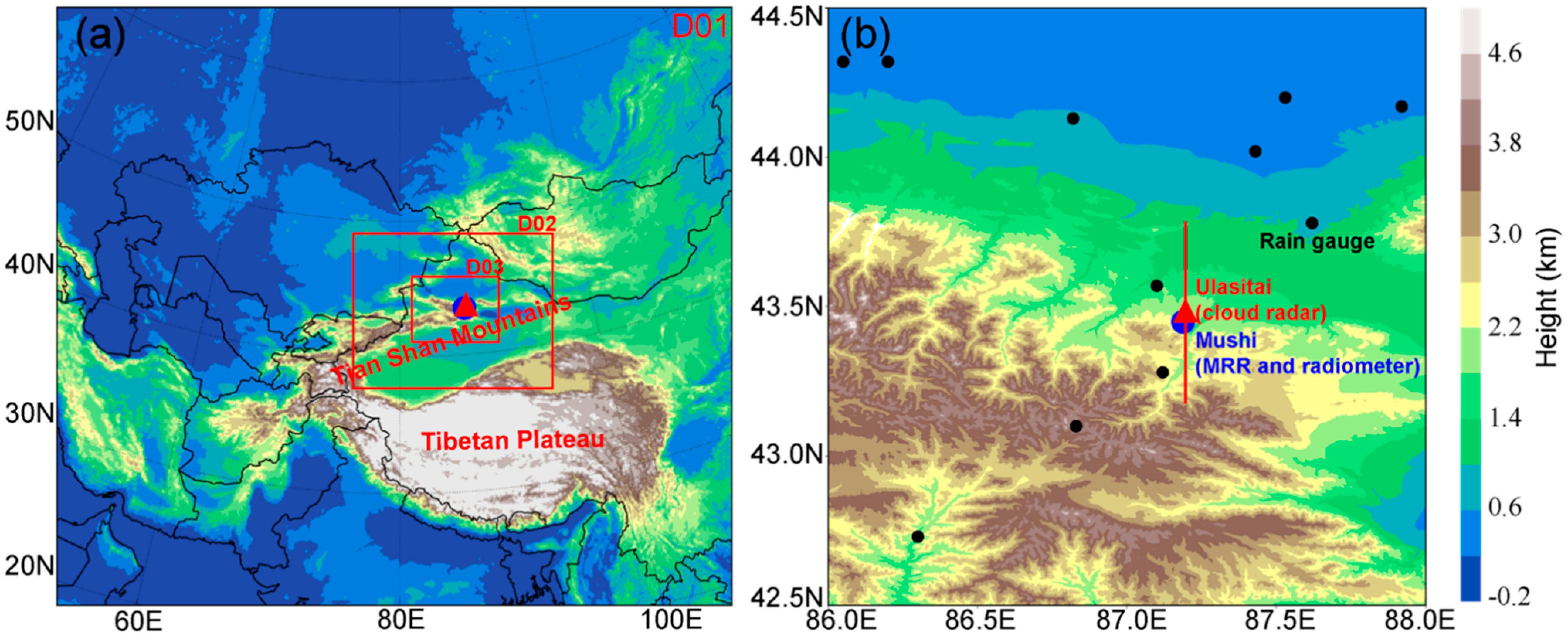

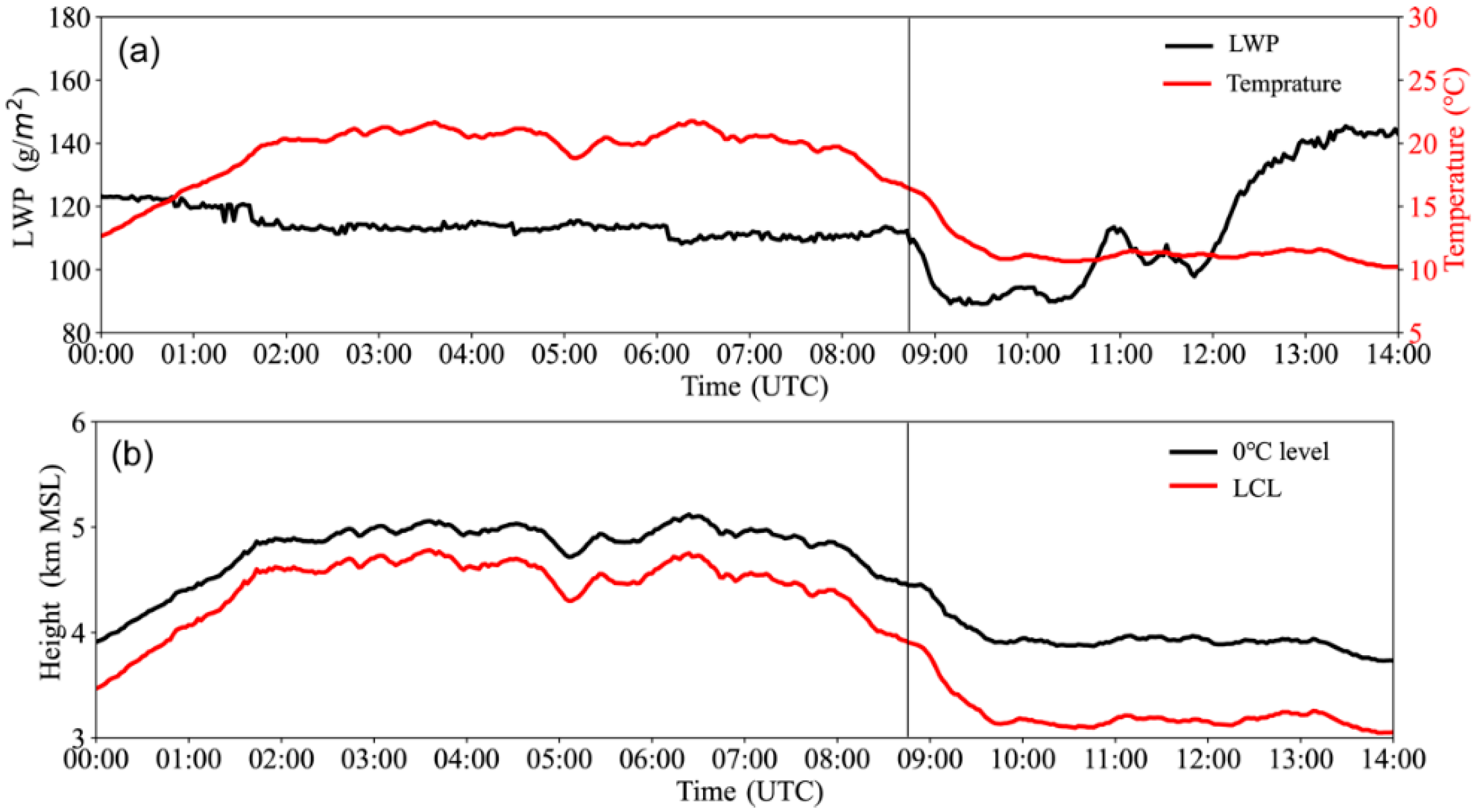

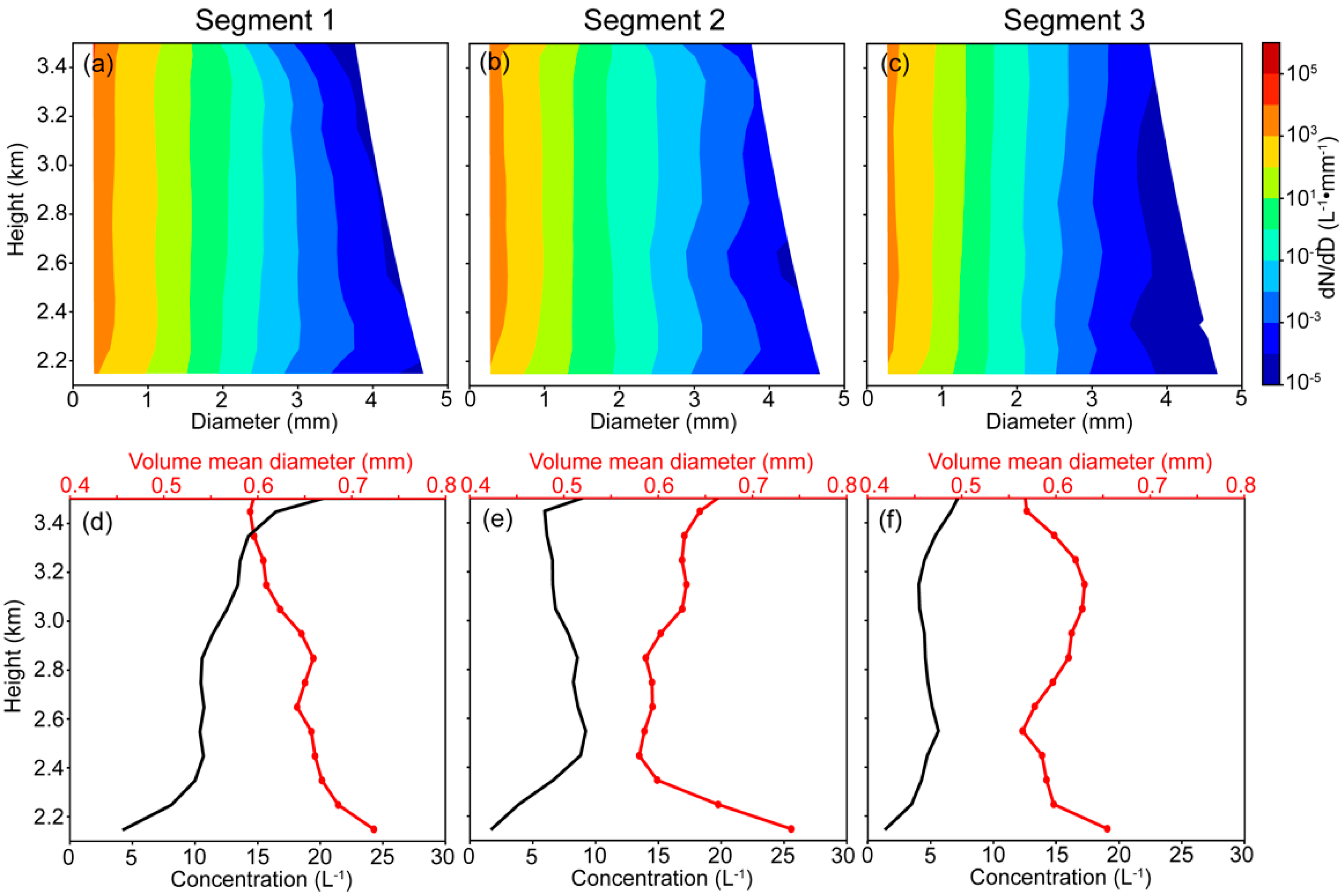
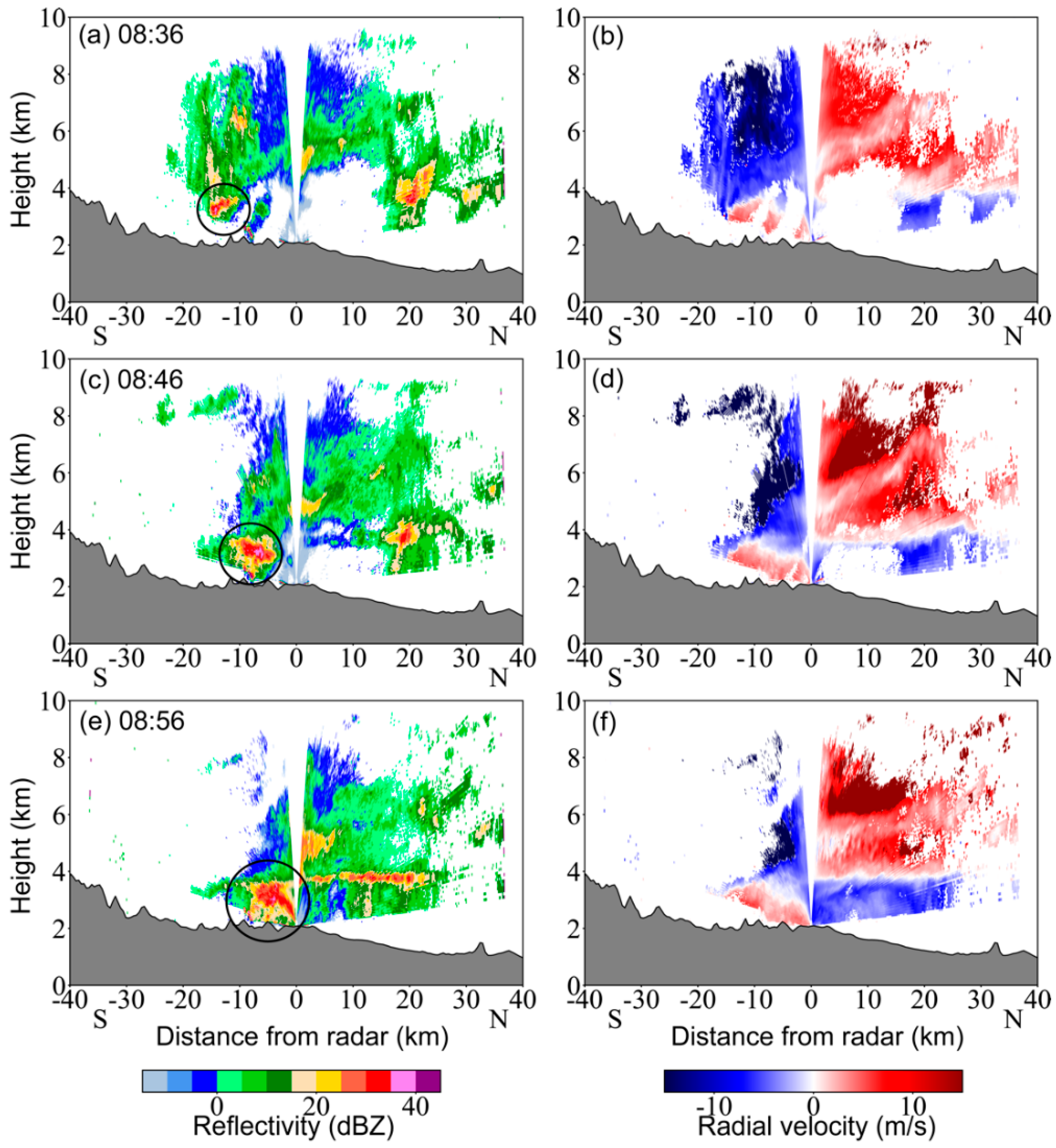


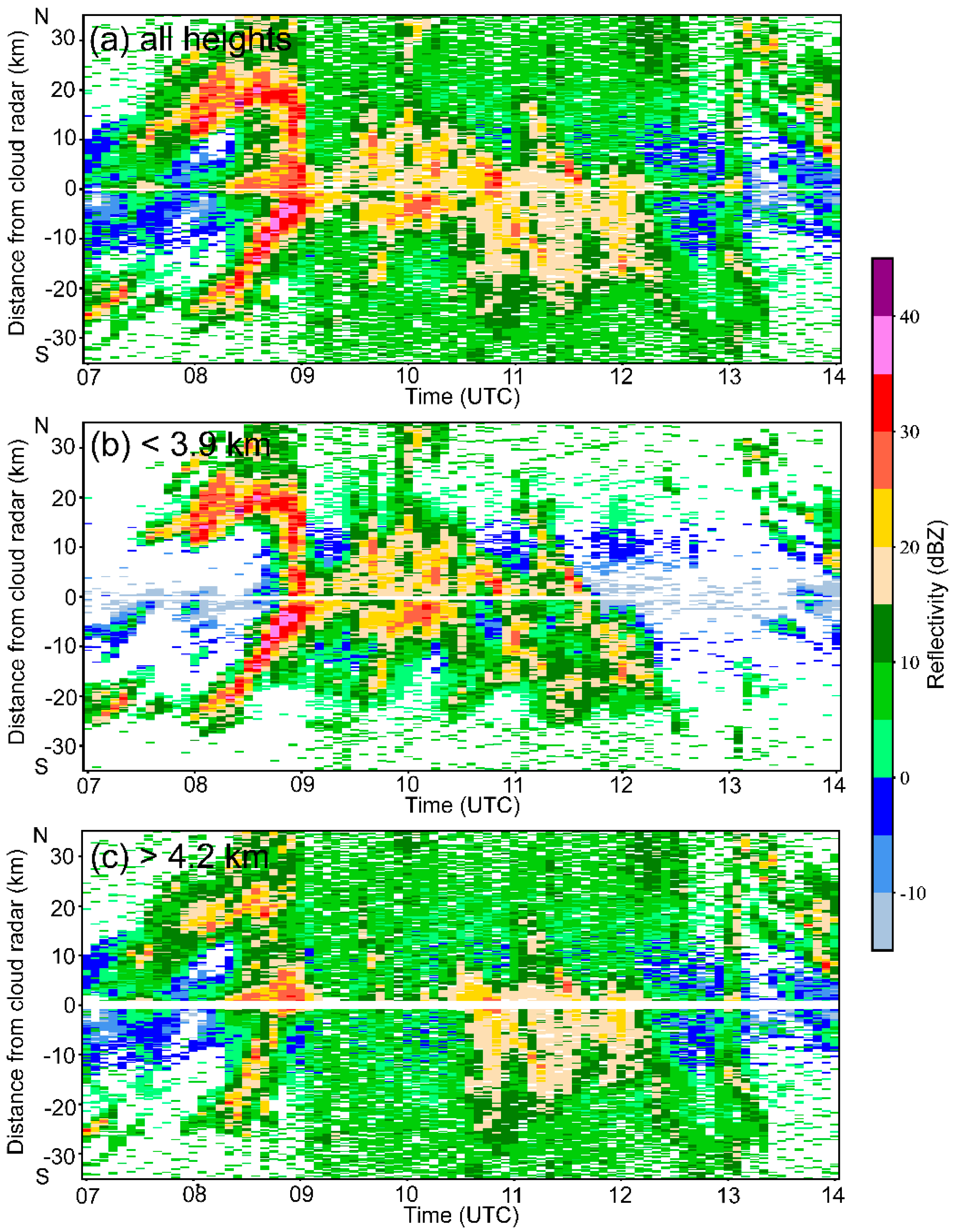
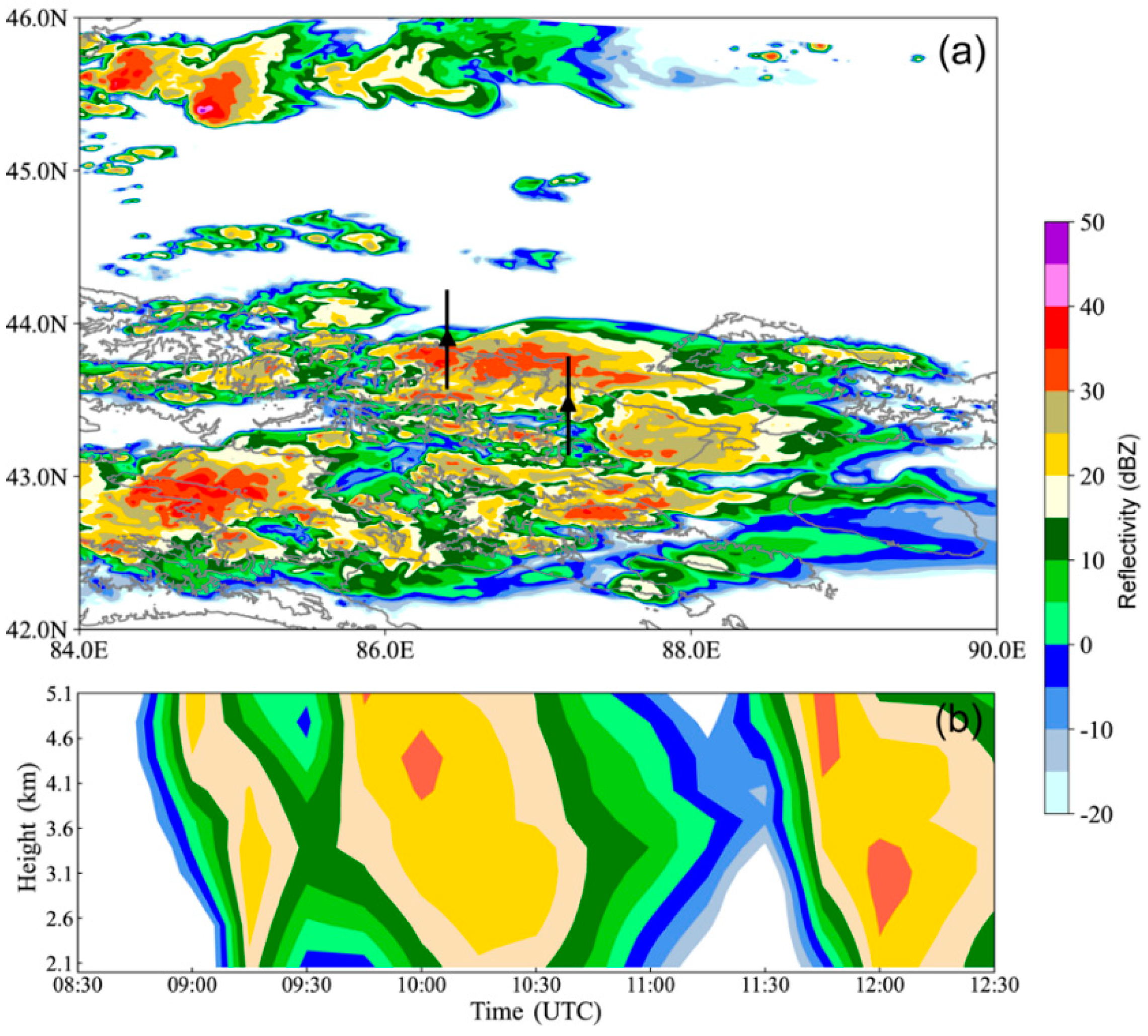
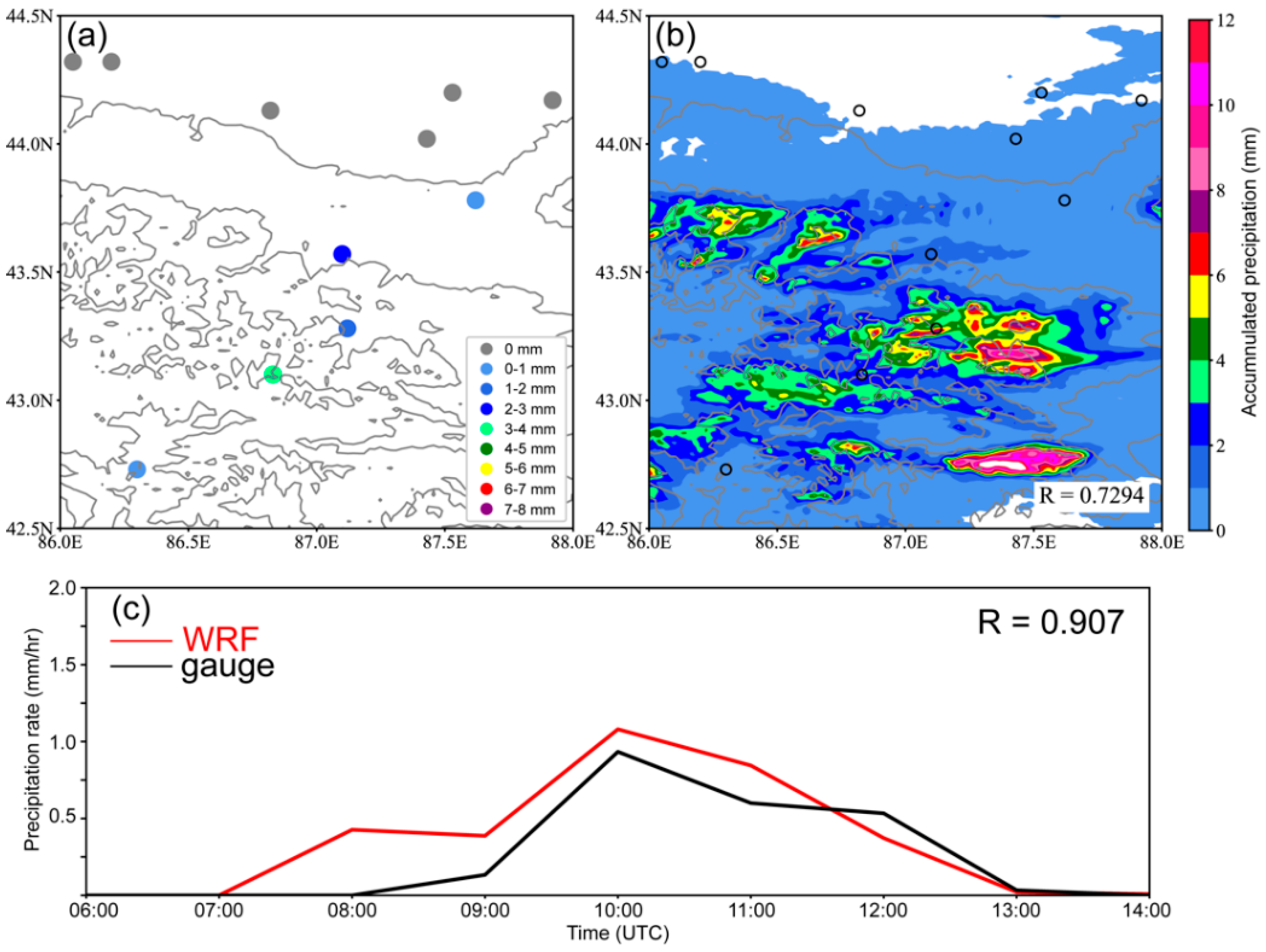


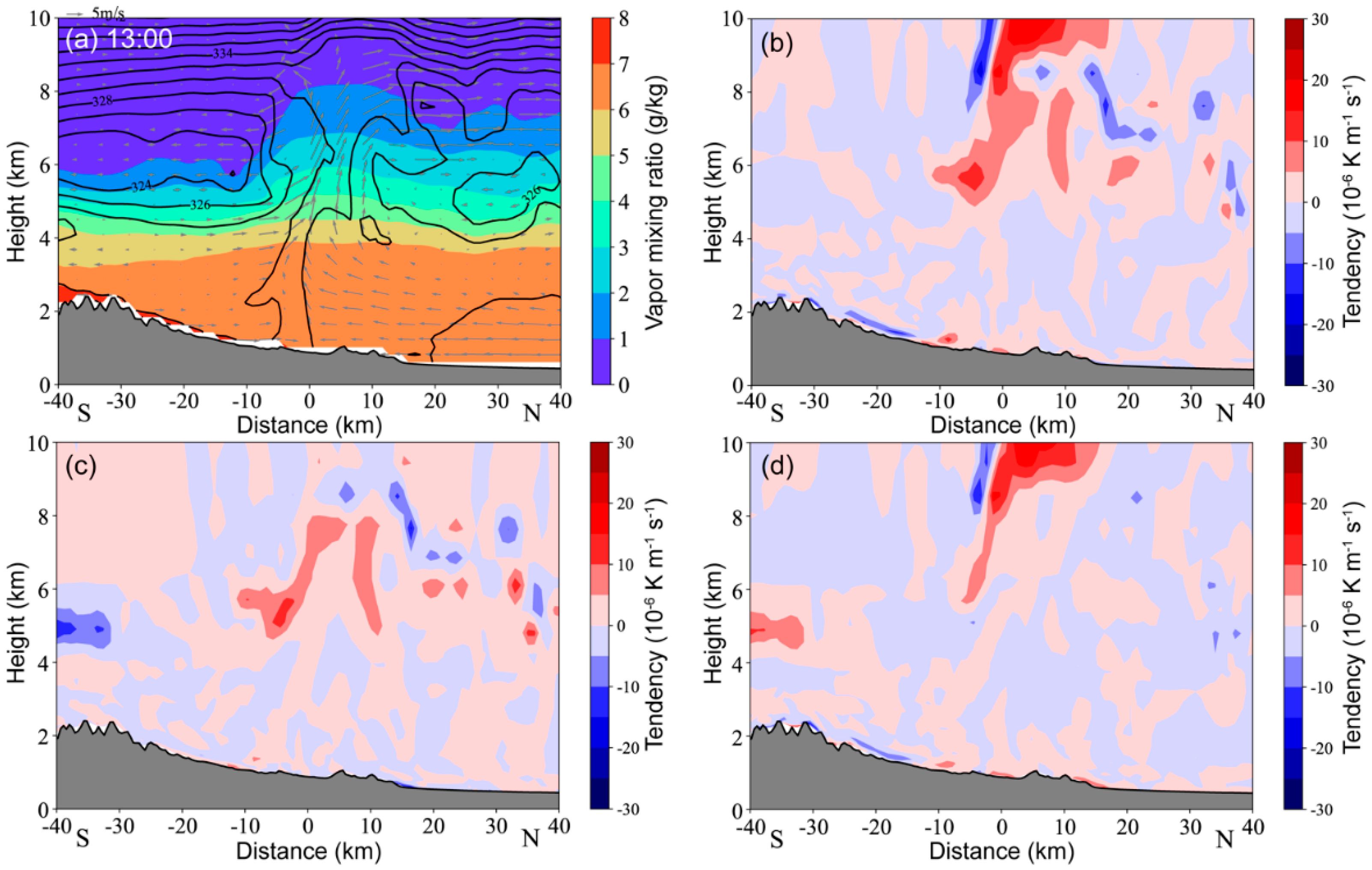
| D01 | D02 | D03 | |
|---|---|---|---|
| Resolution and grids | 9 km, 600 × 500 | 3 km, 511 × 400 | 1 km, 697 × 535 |
| Vertical levels | 33 | ||
| Cumulus | Grell–Freitas scheme | None | |
| Microphysics | Thompson scheme | ||
| Longwave radiation | RRTMG scheme | ||
| Shortwave radiation | RRTMG scheme | ||
| Land surface | Noah scheme | ||
| Surface layer | Monin–Obukhov (Janjic Eta) scheme | ||
| PBL | MYJ scheme | ||
Publisher’s Note: MDPI stays neutral with regard to jurisdictional claims in published maps and institutional affiliations. |
© 2022 by the authors. Licensee MDPI, Basel, Switzerland. This article is an open access article distributed under the terms and conditions of the Creative Commons Attribution (CC BY) license (https://creativecommons.org/licenses/by/4.0/).
Share and Cite
Yang, J.; Liu, E.; Liu, Y.; Lin, Y.; Yin, Y.; Jing, X. Impact of Vertical Wind Shear on Summer Orographic Clouds over Tian Shan Mountains: A Case Study Based on Radar Observation and Numerical Simulation. Remote Sens. 2022, 14, 1583. https://doi.org/10.3390/rs14071583
Yang J, Liu E, Liu Y, Lin Y, Yin Y, Jing X. Impact of Vertical Wind Shear on Summer Orographic Clouds over Tian Shan Mountains: A Case Study Based on Radar Observation and Numerical Simulation. Remote Sensing. 2022; 14(7):1583. https://doi.org/10.3390/rs14071583
Chicago/Turabian StyleYang, Jing, Enhong Liu, Yubao Liu, Yanjun Lin, Yan Yin, and Xiaoqin Jing. 2022. "Impact of Vertical Wind Shear on Summer Orographic Clouds over Tian Shan Mountains: A Case Study Based on Radar Observation and Numerical Simulation" Remote Sensing 14, no. 7: 1583. https://doi.org/10.3390/rs14071583






